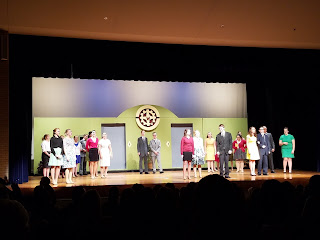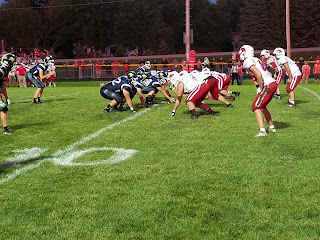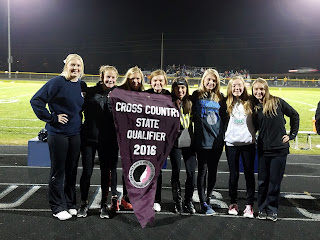Well folks, this is going to be my last post of 2016. I plan to take the next couple of weeks off to enjoy the holidays. Although I plan on being in the district next week during this break in the action, most of my time will be relegated to beginning the initial planning for the 2017-2018 school year. Foremost on the agenda will be creating several draft calendars. It is usually during this work where I have an opportunity to reflect on the year that has just ended. I suppose building a new calendar makes one a bit nostalgic!
What a wonderful year we have had! There is just so much to make us both proud and thankful! Our athletic program has continued to perform at very high levels with several of our teams competing in the state tournament. Many of those accomplishments have been discussed recent posts, but thinking back on the calendar year as a whole: we don't want to forget the excitement of our boys soccer team who also had a very successful run at the state tournament. Remember how hot it was those days?
A big change this year was the retirement of our longtime music teachers, Mrs. Anderson and Mr. Jensen. These high profile positions were ones that we had to make sure that we got right, because there are some high expectations for our music department. As I say to my colleagues, we take our music program pretty seriously at Hudson! Well, the proof is in the pudding because our music program continues to amaze us at performance after performance!
Speaking of retirement, the makeup of our faculty and staff is very different than it was one year ago! In fact, this time last year we really had no idea the number of employees we would have retire. By my count we have nine new faculty members on staff! They are doing an amazing job by the way!
The last couple of weeks I have shared with you some of the outstanding work of our teaching faculty. You now know that not only can we state this based on our observations, but we have been able to begin to quantify these results. A little teaser here: the Iowa School Report Card will be released sometime in early January. I have had an opportunity to have a sneak peak and can't wait to show you the results for our schools!
You have probably also noticed in the last couple of years that I haven't spent much time visiting with you about the status of our budget. That is because we have a healthy budget and are financially stable. I will always advocate for greater funding for our schools, and based on the rhetoric that we are hearing as legislators are gearing up for the legislative session it sounds like we are going to be in for a rough session. The good news is that we currently have reserves that should enable us to weather low state aid. (State aid has been inadequate for years now, but we'll save that for another column after the new year! 😊)
Obviously the biggest driver of our school budget is enrollment, and I reported in October that enrollment was down this year, but it is not something that should be all that concerning. If you read the enrollment report, I shared that based on our projections we should have reached the 'low water mark' in terms of student enrollment. With our smallest class in the district graduating in May, that is good news moving forward. Using what we call the 'cohort methodology' based on a five year rolling average, it appears that our enrollment is set to begin to rise.
Part of that enrollment increase should be attributed to some wise decisions by our city council that will bring more families into our community. As you are already aware, construction in the second addition of Upper Ridges is well underway and the Meadowbrook Condominium project is slated to break ground shortly after the new year.
In all, a pretty good year if you ask me! Fact is, I am pretty excited and stoked to see what comes next! I would like to wish each of you a very Merry Christmas and Happy New Year! I'll see you when school resumes on January 4th.
The last couple of weeks I have shared with you some of the outstanding work of our teaching faculty. You now know that not only can we state this based on our observations, but we have been able to begin to quantify these results. A little teaser here: the Iowa School Report Card will be released sometime in early January. I have had an opportunity to have a sneak peak and can't wait to show you the results for our schools!
You have probably also noticed in the last couple of years that I haven't spent much time visiting with you about the status of our budget. That is because we have a healthy budget and are financially stable. I will always advocate for greater funding for our schools, and based on the rhetoric that we are hearing as legislators are gearing up for the legislative session it sounds like we are going to be in for a rough session. The good news is that we currently have reserves that should enable us to weather low state aid. (State aid has been inadequate for years now, but we'll save that for another column after the new year! 😊)
 |
| Parents join their first graders to build gingerbread houses prior to break. An annual tradition at #hudsonschools! |
Obviously the biggest driver of our school budget is enrollment, and I reported in October that enrollment was down this year, but it is not something that should be all that concerning. If you read the enrollment report, I shared that based on our projections we should have reached the 'low water mark' in terms of student enrollment. With our smallest class in the district graduating in May, that is good news moving forward. Using what we call the 'cohort methodology' based on a five year rolling average, it appears that our enrollment is set to begin to rise.
Part of that enrollment increase should be attributed to some wise decisions by our city council that will bring more families into our community. As you are already aware, construction in the second addition of Upper Ridges is well underway and the Meadowbrook Condominium project is slated to break ground shortly after the new year.
In all, a pretty good year if you ask me! Fact is, I am pretty excited and stoked to see what comes next! I would like to wish each of you a very Merry Christmas and Happy New Year! I'll see you when school resumes on January 4th.
















